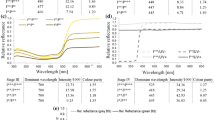Abstract
Bees were trained to react to differences both in the size and in the degree of greyness of discs. To measure the differential sensitivity on these parameters, differences in size and shade of grey (“Δ-intervals”) were established such as lead to a specific choice reaction (Fig. 3). The Δ-intervals may be described for both parameters by Weber's rule (Fig. 4). The main result is the following relationship between the differential sensitivity and the equivalence curve as defined by cross modality matching. The bee treats two discs, which differ from a reference disc in diameter or in degree of greyness, as equivalent when both differ from the reference disc by an equal number of Δ-intervals (Fig. 6). The choice reactions between the reference disc and the discs of the equivalent pair are the same for these parameters. This does not hold for another parameter (Fig. 7A and B). Problems of infering from the Δ-intervals to the differential sensitivity are then discussed.
Similar content being viewed by others
Literatur
Abernethy, C.N., Leibowitz, H.W.: The effect of feedback on luminance thresholds for peripherally presented stimuli. Percept. Psychophys. 10, 172–174 (1971)
Békésy, G.: Experiments in hearing. New York: McGraw-Hill 1960
Blackwell, H.R.: Luminance difference thresholds. In: Handbook of sensory physiology. Vol. VII/4. Jameson, D., Hurvich, L.M. (eds.), pp 78–101. Berlin, Heidelberg, New York: Springer 1972
Fechner, G.Th.: Elemente der Psychophysik, Teil I. Leipzig: Breitkopf und Härtel 1860
Fechner, G.Th.: Über die psychischen Maßprinzipien und das Webersche Gesetz. Phil. Stud. 4, 161–230 (1888)
Fleischer, H.: Über die Größe der durch Phasenänderungen hervorgerufenen Empfindungsänderungen. Acustica 37, 83–93 (1977)
Frisch, K.v.: Der Farbensinn und Formensinn der Biene. Zool. Jahrb., Abt. Allgem. Zool. Physiol. Tiere 35, 1–182 (1915)
Gibson, J.J.: Die Sinne und der Prozeß der Wahrnehmung. Bern: Huber (1973)
Heinemann, E.G.: The relation of apparent brightness to the threshold for differences in luminance. J. Exp. Psychol. 61, 389–399 (1961)
Hörmann, M.: Über den Helligkeitssinn der Bienen. Z. Vergl. Physiol. 21, 188–219 (1935)
Johnson, C.A., Leibowitz, H.W.: Practice, refractive error, and feedback as factors influencing peripheral motion thresholds. Percept. Psychophys. 15, 276–280 (1974)
Krantz, D.H.: Visual scaling. In: Handbook of sensory physiology, Vol. VII/4: Visual psychophysics, Jameson, D., Hurvich, L.M. (eds.), pp. 661–689. Berlin, Heidelberg, New York: Springer 1972
Kunze, P.: Untersuchung des Bewegungssehens fixiert fliegender Bienen. Z. Vergl. Physiol. 44, 656–684 (1961)
Kurtenbach, W.: Dressurexperimente mit Bienen: Unterscheidung von Graustufen bei konstantem Untergrund. Staatsexamensarbeit an der Fak. f. Biologie. Freiburg/Br. 1975
Labhart, T.: The discrimination of light intensities in the honey bee. In: Information processing in the visual system of arthropods. Wehner, R. (ed.), pp. 115–119. Berlin, Heidelberg, New York: Springer 1972
Lilienthal, M.G., Dawson, W.E.: Inverse cross-modality matching: A test of radio judgement consistency for group and individual data. Percept. Psychophys. 19, 252–260 (1976)
Linker, E., Moore, M.E., Galanter, E.: Taste thresholds, detection models, and disparate results. J. Exp. Psychol. 67, 59–66 (1964)
MacKay, D.M.: Psychophysics of perceived intensity: A theoretical basis for Fechner's and Stevens' law. Science 139, 1213–1216 (1963)
Mackintosh, N.J.: The psychology of animal learning. London, New York, San Francisco: Academic Press 1974
Marks, L.E., Stevens, J.C.: Individual brightness functions. Percept. Psychophys. 1, 17–24 (1966)
Marks, L.E.: Sensory processes: The new psychophysics. New York, London: Academic Press 1974
Mashhour, M., Hosman, J.: On the new “psychophysical law”: A validation study. Percept. Psychophys. 3, 367–375 (1968)
Matthews, M.L.: Visual size difference discrimination: Effect of disc size and retinal locus. Percept. Psychophys. 6, 160–162 (1969)
Newman, E.B.: The validity of the just noticeable difference as a unit of psychological magnitude. Trans. Kans. Acad. Sci. 36, 172–175 (1933)
Ono, H.: Difference threshold for stimulus length under simultaneous and nonsimultaneous viewing conditions. Percept. Psychophys. 2, 201–207 (1967)
Ronacher, B.: Äquivalenz zwischen Größen- und Helligkeitsunterschieden im Rahmen der visuellen Wahrnehmung der Honigbiene. Biol. Cybernetics 32, 63–75 (1979)
Ronacher, B.: Beitrag einzelner Parameter zum wahrnehmungsgemäßen Unterschied von zusammengesetzten Reizen bei der Honigbiene. Biol. Cybernetics 32, 77–83 (1979)
Rule, S.J., Markley, R.P.: Subject differences in crossmodality matches: Percept. Psychophys. 9, 115–117 (1971)
Stevens, S.S.: On the psychophysical law. Psychol. Rev. 64, 153–181 (1957)
Stevens, S.S.: Cross modality validation of subjective scales for loudness, vibration and electric shock. J. Exp. Psychol. 57, 201–209 (1959)
Stevens, S.S.: To honor Fechner and repeal his law. Science 133, 80–86 (1961)
Stevens, S., Guirao, M.: Subjective scaling of length and area and the matching of length to loudness and brightness. J. Exp. Psychol. 66, 177–186 (1963)
Stevens, S.S.: On predicting exponents for cross-modality matches. Percept. Psychophys. 6, 251–256 (1969)
Suchowerskyj, W.: Untersuchungen über die subjektive Bewertung von Unterschieden zwischen akustischen Signalen. Dissertation and der TU München, 1976
Suchowerskyj, W.: Beurteilung von Unterschieden zwischen aufeinanderfolgenden Schallen. Acustica 38, 131–139 (1977)
Teghtsoonian, R.: On the exponents in Stevens law and the constant in Ekmans law. Psychol. Rev. 78, 71–80 (1971)
Terhardt, E.: Über ein Äquivalenzgesetz für Intervalle akustischer Empfindungsgrößen. Kybernetik 5, 127–133 (1968)
Terhardt, E.: Psychoacoustic evaluation of musical sounds. Percept. Psychophys. 23, 483–492 (1978)
Wolf, E.: The visual intensity discrimination of the honey bee. J. Gen. Physiol. 16, 407–422 (1933)
Zwicker, E., Feldtkeller, R.: Das Ohr als Nachrichtenempfänger, 2. Aufl. Stuttgart: Hirzel 1967
Author information
Authors and Affiliations
Rights and permissions
About this article
Cite this article
Ronacher, B. Ein einfacher zusammenhang zwischen der äquivalenzbeziehung und der unterschiedsempfindlichkeit für zwei musterparameter bei der honigbiene. Biol. Cybernetics 36, 51–61 (1980). https://doi.org/10.1007/BF00337022
Received:
Issue Date:
DOI: https://doi.org/10.1007/BF00337022




